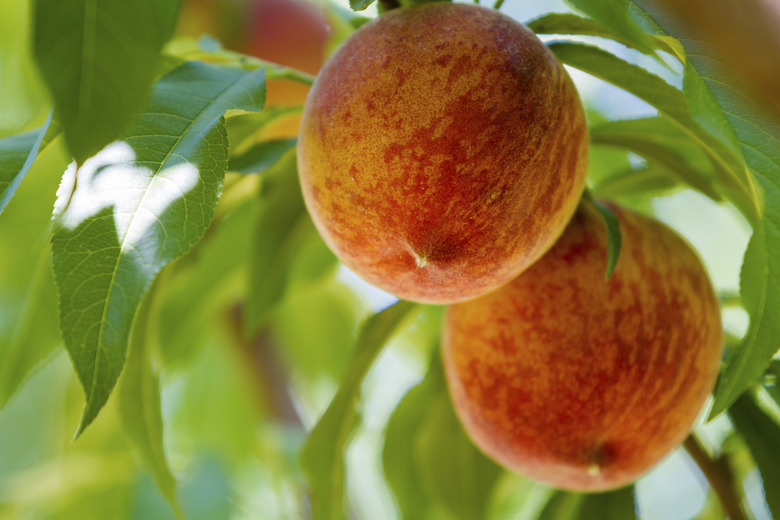List Of Plants & Animals In Georgia
The state of Georgia in the United States has many different plants and animals, including endangered species. Several of these endangered species provide important benefits to humans or the environment. Georgia is home to a wide variety of trees, shrubs, birds, mammals, reptiles, amphibians and more.
Trees in Georgia
Trees in Georgia
Many tree species grow in Georgia. You can find a variety of different sizes and types of trees, including beech, holly, walnut, oak, cypress, hemlock, cedar, ash, hickory, pine, palm, magnolia, maple, birch, poplar and sycamore. Georgia is also well known for its production of peach trees.
Shrubs in Georgia
Shrubs in Georgia
Georgia is home to numerous shrub species, including those that produce berries and those that do not. Some of the many shrubs native to Georgia include blueberry, buckeye, deerberry, honeycup, hydrangea, laurel, palmetto, rhododendron, sparkleberry, strawberry, sumac and witch hazel.
Mammals in Georgia
Mammals in Georgia
Wildlife in Georgia is plentiful, and many different mammals live and thrive in Georgia and the surrounding states. Georgia is home to armadillos, bats, moles, beavers, mice, rats, rabbits, squirrels and white-tailed deer, among other species. Many predators also thrive in this state, including bears, bobcats, coyotes, gray and red foxes, mink, mountain lions, raccoons, river otters, skunks and opossums.
Birds in Georgia
Birds in Georgia
When scanning the skies of Georgia, you're liable to spot any number of different birds. Songbirds such as blackbirds, bluebirds, cardinals, chickadees, doves, finches, grackles, hummingbirds, mockingbirds, robins, sparrows and swallows all make Georgia their home. Birds of prey also soar through the air, and common sightings include eagles, falcons, hawks, kites, owls, ospreys and vultures.
Reptiles and Amphibians in Georgia
Reptiles and Amphibians in Georgia
Some of the reptiles that live in Georgia include alligators, tortoises, lizards, snakes, sea turtles, skinks and turtles. The state is also home to a number of different amphibians as well, such as frogs, mudpuppies, newts, salamanders and toads.
Endangered Species in Georgia
Endangered Species in Georgia
A number of rare and endangered species live in or pass through Georgia. Endangered species in Georgia receive protection from state and sometimes federal government agencies.
You might already know some rare and threatened species, like sea turtles or eagles. However, many important endangered species don't get nearly the same notoriety as these charismatic and beloved animals. It's often these less understood species, such as the gray myotis bat, the rusty patched bumble bee, and the eastern indigo snake, that make an important difference in their ecosystem.
Gray Myotis Bat
Gray Myotis Bat
One great example of an endangered species in Georgia that you might have never heard of before is the gray myotis bat. This small bat species lives in the southeast United States. The gray myotis bat, like many bats, feasts upon insects at night. They prey on mosquitoes and thus help reduce mosquito-borne disease by reducing populations of this pest.
The greatest threat to the gray myotis bat is cave disturbance during hibernation and breeding. This makes habitat protection extremely important to their survival. During the breeding season, the mother bats will drop their young and fly away if disturbed, leaving them to perish. By protecting important habitats, researchers have been able to halt population decline and even increase bat populations in certain regions.
Rusty Patched Bumble Bee
Rusty Patched Bumble Bee
The rusty patched bumble bee, a critically endangered species, lives in northern Georgia. The rusty patched bumble bee used to have healthy populations, but their numbers crashed recently and researchers are still determining the cause. The main threats to the continued survival of this species include habitat loss, climate change and the use of pesticides.
Like many bee species, the rusty patched bumble bee is an important pollinator to native plant species. These pollinators also help farmers with the pollination of crops as well. Without pollinators, many different plants and fruits would not survive.
Eastern Indigo Snake
Eastern Indigo Snake
Eastern indigo snakes live in southern Georgia. Humans have decimated the populations of eastern indigo snakes through habitat destruction and direct persecution. Eastern indigo snakes also faced population decline from capture for the pet trade in the past, but they now have state and federal protection.
This snake species, like most snakes, provides important pest control. They eat rats, mice and other rodents, which feed on crops and spread disease. In addition, the eastern indigo snake also hunts venomous and potentially dangerous snake species, such as rattlesnakes. The eastern indigo snake itself is non-venomous and harmless to people and pets.
Cite This Article
MLA
Zinni, Yasmin. "List Of Plants & Animals In Georgia" sciencing.com, https://www.sciencing.com/list-plants-animals-georgia-6671518/. 30 September 2021.
APA
Zinni, Yasmin. (2021, September 30). List Of Plants & Animals In Georgia. sciencing.com. Retrieved from https://www.sciencing.com/list-plants-animals-georgia-6671518/
Chicago
Zinni, Yasmin. List Of Plants & Animals In Georgia last modified March 24, 2022. https://www.sciencing.com/list-plants-animals-georgia-6671518/
